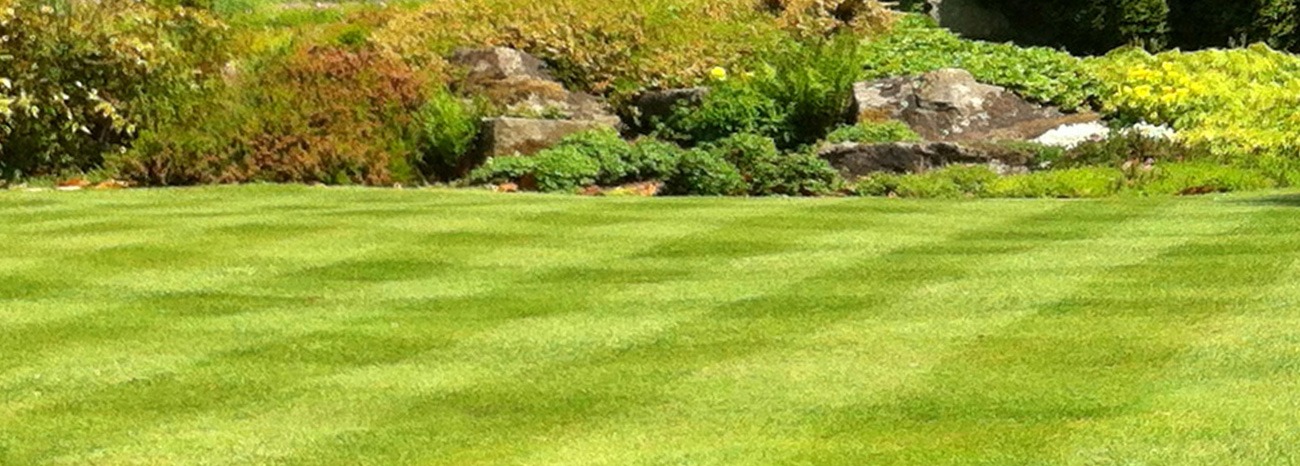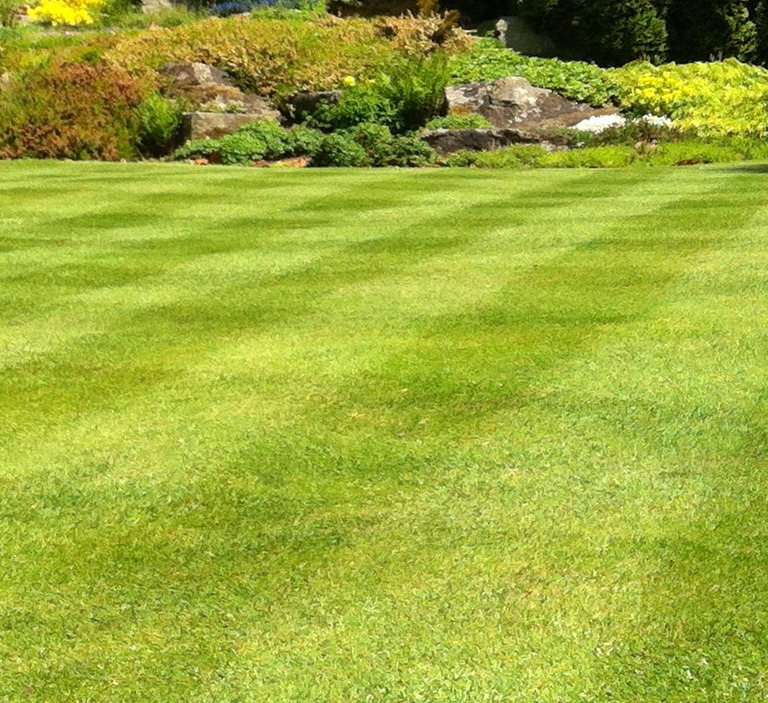There’s just something about a perfectly striped lawn, the kind that looks like it belongs on a baseball field or in a magazine. It’s the way the stripes catch the light, instantly giving your yard a polished, professional look.
Here’s the thing, you don’t need to hire a pro to get those clean lines. With the right mowing technique, a little practice, and healthy grass, you can learn how to stripe your lawn and create that same standout effect.
We’ll cover how lawn striping works, what you’ll need to get started, how to create basic and advanced patterns, plus a few pro tips to help your stripes really pop.
What Makes a Striped Lawn?
Even though it looks that way, lawn stripes aren’t actually cut into the grass. The striping appears because of the way light reflects off the blades of grass after they’ve been bent in different directions.
When you mow in one direction, the grass blades bend away from you. On your return pass, the grass bends toward you. The side of the blade you see reflects light differently. Blades bent away from you look lighter and blades bent toward you look darker. That’s how you get the signature light and dark striping effect.
The healthier and thicker your grass, the bolder your stripes will look. That’s why a solid lawn care program is a great foundation to a striped lawn.
Is Your Lawn Ready for Stripes?
Before you start striping, you’ll need to make sure your lawn is ready. The best results come from working with the right grass type and following good mowing and maintenance practices.
What Types of Grass Stripe Best?
- Cool-season grasses: like fescue, bluegrass and ryegrass, are ideal because their blades bend more easily and hold patterns better.
- Warm-season grasses: like Bermuda and Zoysia can be striped, but the contrast may not be as dramatic. You’ll usually want to mow these a little higher and use a roller to really enhance the striping.
Choosing the Right Equipment
Here’s what you’ll need to get started:
Basic Setup
- A standard lawn mower (walk-behind or riding)
- Make sure your mower blades are sharp
- Optional: a DIY drag mat or simple striping attachment
Upgrades for More Dramatic Stripes
- A striping kit or roller (these attach to your mower and help bend the grass more effectively)
- A reel mower for ultra-precise cuts (great for golf-course-level results)
Safety First
- Wear hearing protection and safety glasses
- Gloves can help with grip and comfort, especially if you’re mowing a large area
Ideal Mowing Height
The sweet spot for striping is to keep your grass at a height of 2.5-to-3.5 inches. Taller grass bends more and reflects more light, giving better contrast.
As you mow, keep these tips in mind.
- We’ll say it again. Keep your mower blade sharp. A clean cut looks better and is healthier for your lawn.
- Make sure your mower deck is level and the tires are properly inflated to prevent uneven mowing.
- Include regular fertilization in your mowing regimen. Keeping a thick, healthy turf will hold the patterns longer.
Step-by-Step: How to Stripe Your Lawn
- Start with a Straight Pass: Start by picking a straight edge in your yard. This can be a driveway, sidewalk, fence line or even a flower bed. Use this as your guide for your very first pass. Take your time and mow slow and steady because this first stripe will set the tone and angle for the rest of your lawn.
- Alternate Your Passes: When you turn around for your next pass, line up your mower so the wheels slightly overlap the edge of the stripe you just made. This small overlap helps avoid leaving any gaps or uneven edges between the stripes.As you mow back and forth, try to make gentle Y-shaped turns at the ends of each row. This prevents wear and tear on your grass. Over time, making sharp turns can damage the turf or create bald spots.
- Try Advanced Patterns: Once you’re comfortable with basic stripes, it’s fun to try out more creative patterns:
- Checkerboard: After mowing a set of stripes in one direction, mow a second set of stripes at 90 degrees to your first set.
- Diamonds: Start with a checkerboard, then mow diagonal stripes across it.
- Waves: For curved patterns, use gentle steering. Don’t be discouraged if it doesn’t look the way you pictured it. This takes practice to get the pattern looking just right.
- Final Touches: When you’re done mowing, give your lawn a quick pass with a roller if you have one. This helps bend the grass even more and really sharpens up the stripes. Finally, blow off any loose clippings so the pattern looks clean and defined.
Pro Tips for the Best Stripes
- Overlap your wheels slightly: to get clean, even stripes with no gaps
- Use string lines or chalk lines: if you’re mowing long stretches and want extra-straight reference guides
- Switch up your patterns: do this every few weeks to prevent turf wear and to keep your lawn looking fresh
Common Mistakes to Avoid
- Mowing too close: grass that’s cut too low won’t bend enough to show stripes.
- Turning too sharply: this can scalp or tear the grass.
- Using dull blades or mowing too quickly: both can make your stripes look ragged instead of clean.
Keep Your Lawn Looking Its Best
If you want consistent, bold stripes all season long, it all comes down to keeping your lawn healthy. Here’s how:
- Follow a proper watering and fertilizing schedule. A well-fed, hydrated lawn grows thicker and holds stripes better.
- Aerate and overseed as needed to keep your lawn dense and healthy.
- Rotate your mowing pattern regularly to avoid compacted tracks.
Ready to Take Your Lawn to the Next Level?
If you want to give your lawn every advantage to get vibrant color, thick growth, and patterns that really pop, our Total Green lawn plan can help.
If you’d like to schedule a time to find out what we can do for you, call 215.799.2016.
Frequently Asked Questions
Q: How long will lawn stripes last before they fade?
A: Most stripes will remain visible for about a week, depending on how fast your grass grows and how often you mow.
Q: Can striping damage grass if done too often?
A: No. As long as you’re mowing correctly and not over-stressing the grass, striping is safe to do regularly.
Q: What’s the difference between a striping kit and a roller?
A: Both help bend the grass. A striping kit attaches to your mower, while a roller can be pushed or towed separately for more dramatic results.
Q: Is it possible to stripe warm-season grasses like Bermuda or Zoysia?
A: Yes, although the stripes won’t be as bold as with cool-season grasses. You’ll get the best results by mowing a bit higher and using a roller.
Q: How do I remove existing uneven stripes and start fresh?
A: Mow the entire lawn in one consistent direction at a 90-degree angle to your previous pattern. This will help “reset” the blade direction and give you a clean slate.


